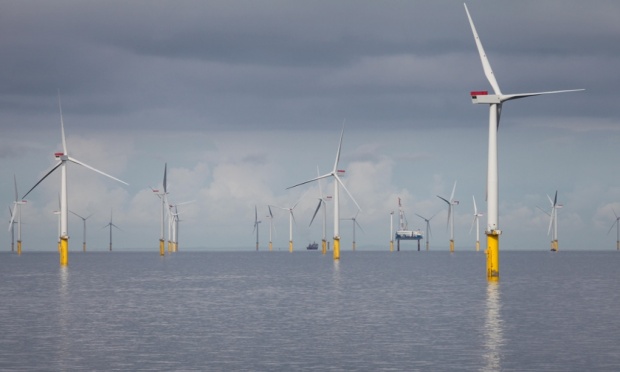World’s Biggest Offshore Windfarm Approved for UK Yorkshire Coast
ENERGY, 23 Feb 2015
Dogger Bank Creyke Beck project will cover 430 sq miles and is expected to generate enough electricity to power nearly 2m homes, supporting 900 jobs.

The Gwynt y Mor offshore windfarm off the coast of north Wales. The Dogger project will be an array of up to 400 turbines 80 miles off the Yorkshire coast. Photograph: Alamy
17 Feb 2015 – Plans for the world’s biggest offshore windfarm have been given the green light by the energy secretary, with planning permission for an array of up to 400 turbines 80 miles off the Yorkshire coast on the Dogger Bank.
The project, more than twice the size of the UK’s current biggest offshore windfarm, is expected to cost £6bn to £8bn and could fulfil 2.5% of the UK’s electricity needs.
Covering about 430 sq miles, the Dogger Bank Creyke Beck project will – if fully constructed – generate enough electricity to power nearly 2m homes, and could support an estimated 900 jobs in Yorkshire and Humberside, according to the government.
Ed Davey, the Liberal Democrat energy and climate change secretary, said: “Making the most of Britain’s home-grown energy is creating jobs and businesses in the UK, getting the best deal for consumers and reducing our reliance on foreign imports. Wind power is vital to this plan, with £14.5bn invested since 2010 into an industry which supports 35,400 jobs.”
Although the UK does not manufacture large wind turbines, the Department of Energy and Climate Change says half of the costs associated with building and operating a windfarm are spent buying services and products from UK businesses.
Dogger has long been mooted as a possible location for offshore windfarms, because the shallow seabed, only about 30 metres deep, should make it easier to lay foundations and construct large turbines there, but no company has yet ventured into the area.
If built, the Creyke Beck turbines would be the furthest offshore that have ever been attempted. They would be the first stage of a project that could eventually be three times the size, if further tranches are also constructed.
Nick Medic, director of offshore renewables at RenewableUK, the wind industry association, said: “This is an awesome project and will surely be considered as one of the most significant infrastructure projects ever undertaken by the wind industry. Dogger Bank demonstrates the sheer potential of offshore technology to turn our vast ocean and wind resources into green energy.
“It is a project that pushes the offshore engineering envelope, demonstrating how far this technology has evolved in the 10 short years since the first major offshore windfarm was installed in North Hoyle just five miles from shore.”
Construction of the first turbines could still be years away, however. The Forewind consortium which is behind the 2400MW capacity project has yet to make a final investment decision. The consortium comprises Scottish and Southern Energy, Germany’s RWE, and Norway’s Statoil and Statkraft, the former the country’s majority state-owned oil business and the latter its state-owned electricity company.
Though the granting of planning permission may encourage a positive decision, the falling oil price and uncertainty over what may happen to wind energy subsidies after the general election make long-term investments in the sector more fraught.
About £60m has been spent by the companies so far on surveys alone.
“Achieving consent for what is currently the world’s largest offshore wind project in development is a major achievement and will help confirm the UK’s position as the world leader in the industry,” said Tarald Gjerde, general manager for Forewind.
The consortium said the Creyke Beck project could create up to 4,750 new direct and indirect full-time equivalent jobs and generate more than £1.5bn for the UK economy, especially in Yorkshire and Humberside owing to their “historic strengths, existing skills in large-scale production activities and a marine support legacy”.
The UK’s last biggest offshore wind site, the London Array, ran into difficulties soon after gaining the government’s green light in a long drawn-out process from 2005 to 2007. Costs spiralled, investors withdrew backing and the future of the project for long periods hung in the balance. However, the windfarm, with 175 turbines, was inaugurated in 2013.
The UK currently has about 1,200 offshore wind turbines, with a total generating capacity of about 4GW.
Go to Original – theguardian.com
DISCLAIMER: The statements, views and opinions expressed in pieces republished here are solely those of the authors and do not necessarily represent those of TMS. In accordance with title 17 U.S.C. section 107, this material is distributed without profit to those who have expressed a prior interest in receiving the included information for research and educational purposes. TMS has no affiliation whatsoever with the originator of this article nor is TMS endorsed or sponsored by the originator. “GO TO ORIGINAL” links are provided as a convenience to our readers and allow for verification of authenticity. However, as originating pages are often updated by their originating host sites, the versions posted may not match the versions our readers view when clicking the “GO TO ORIGINAL” links. This site contains copyrighted material the use of which has not always been specifically authorized by the copyright owner. We are making such material available in our efforts to advance understanding of environmental, political, human rights, economic, democracy, scientific, and social justice issues, etc. We believe this constitutes a ‘fair use’ of any such copyrighted material as provided for in section 107 of the US Copyright Law. In accordance with Title 17 U.S.C. Section 107, the material on this site is distributed without profit to those who have expressed a prior interest in receiving the included information for research and educational purposes. For more information go to: http://www.law.cornell.edu/uscode/17/107.shtml. If you wish to use copyrighted material from this site for purposes of your own that go beyond ‘fair use’, you must obtain permission from the copyright owner.